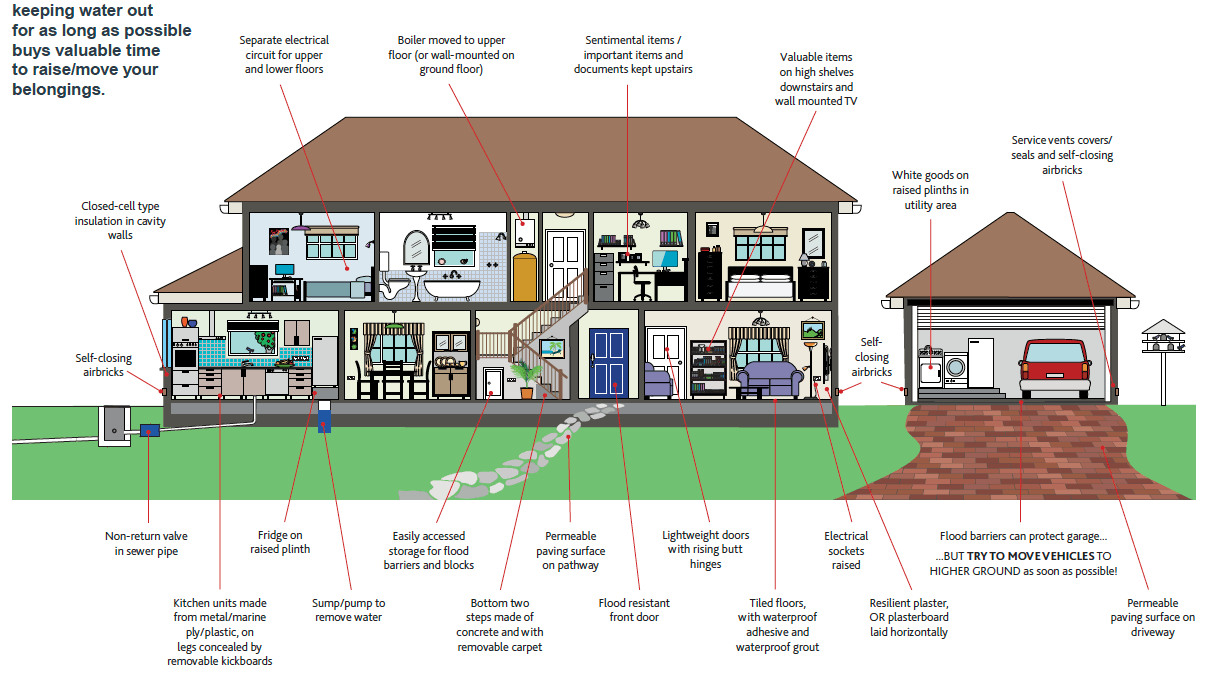Living with flooding: action plan
Living with flooding recommends actions for a range of stakeholders to take to help promote property flood resilience in Scotland.
Combined resistance and resilience measures

What is Property Flood Resilience?
Property Flood Resilience (PFR) helps to make buildings more resilient to the physical impacts of flooding and to lessen the emotional impacts for people. Properties will usually require a package of measures, some of which prevent water entering the property (resistance measures) and others that minimise the impact should water enter the house (resilience measures), speeding up the recovery process. In this action plan PFR covers both types of measure. Examples include:
- flood doors
- flood barriers
- air brick covers
- pointing or waterproofing brickwork
- installing non-return valves
- moving vulnerable features, such as sockets, above floor level
- Replacing carpets with flooring that does not need to be replaced after a flood,
- Using materials for kitchen cupboards that are less likely to need replaced after a flood.
“Flooding will become more frequent in future and some properties will flood repeatedly.”
In some circumstances it is better to let water in. For floods over 60cm depth, or of prolonged duration, attempting to keep the water out can cause serious structural damage because of the different water pressures either side of the walls. It is important that property owners understand both the benefits and limitations of PFR to help them decide the best way to protect their property.
Why do we need an Action Plan?
Flooding will become more frequent in future and some properties will flood repeatedly. Take up of PFR is very low in Scotland because people are often unaware of the products and materials that can limit flood damage, or they consider a flood event as a ‘one off’. Action is needed to ensure that owners and occupiers have reliable information about how they can limit flood damage to their homes and businesses.
PFR is however a new industry and it is difficult to find relevant and reliable information about how to make a property more resilient, whether it is an existing building or a new building at risk from flooding. Also, people need reliable information about the different flood products on the market that can help stop flood water entering a property.
The Framework for delivering property flood resilience in Scotland3, published in December 2018, recommended that the PFRDG was set up to promote PFR in Scotland. The PFRDG includes representatives (full list available in Appendix A) from Scottish Government, the insurance industry, The Scottish Flood Forum, SEPA, local authorities and private sector companies.
Flood Re was launched in 2016 to promote the availability and affordability of flood insurance for eligible homes across the UK.
The scheme will end in 2039 and Flood Re is also managing over that time the transition to an affordable market for household flood insurance where prices reflect the risks of flooding. PFR measures have a vital role to play in homes at risk of flooding.
The PFRDG recommends that we use this opportunity to ensure that people have the best information to make their property more resilient to flooding. The PFRDG has identified key areas to develop and has produced this two-year Action Plan. Some of the objectives will complete within two years but others will encourage and inform change over a longer term. A review of the work of the group will take place in June 2021. The PFRDG will work collaboratively and with wider industries and sectors to deliver the aim and objectives of the action plan and encourage PFR.
Contact
Email: debi.garft@gov.scot
There is a problem
Thanks for your feedback